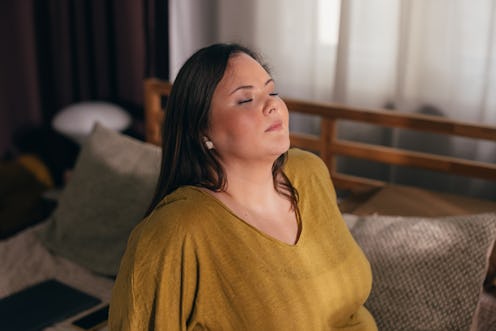
TikTok is always calling me out, especially when it comes to stress and anxiety. It’s almost like it knows when I’ve been holding my breath a little more often than usual, and that’s when breathing techniques — like the double inhale — start to fill up my FYP.
As I watched a few videos, I learned that the double inhale isn’t just your regular, run-of-the-mill stress-relieving breathing technique, but one that’s considered to be the fastest and easiest way to eject yourself out of a state of anxiety, so you can softly land back into a state of calm.
To break it down, this technique — also known as a physiological sigh — is as simple as breathing in fully through your nose, pausing, and then taking a second, short sip of air through your nose, followed by a long exhale through your mouth, says psychologist Roberta T. Ballard, Ph.D.
Apparently, it’s that second, sharp sniff that sets it apart. “It [works by popping] open the air sacs in your lungs that might have collapsed due to the shallow, rapid breathing associated with being stressed out,” she tells Bustle. These deep inhales are said to help you feel refreshed and refocused, which is why this method is often suggested by therapists and life coaches.
While you can’t see or feel your air sacs, I would not be surprised at all if mine were as deflated as deflated can be, and that’s why I’ve started breathing in twice whenever I need to chill out — in order to give my body a little refresh.
Keep reading below for more info about double inhales, as well as how to give them a try.
What To Know About The Double Inhale
The double inhale isn’t a new technique, Ballard says, but the novelty of it, as well as its simplicity, is likely why it’s taking off on TikTok — where it has nearly 20 million views. Of course, it also doesn’t hurt that it’s so effective.
According to Ballard, it’s the ideal breathing exercise to try in peak moments of anxiety, like right before a big meeting.But it also works at random intervals throughout the day. “Practicing it when you aren’t stressed is also a good idea, as it can help reduce your overall stress levels on a more general basis,” she says.
As a bonus, this breath can also come in clutch when you need to focus, which is another perk I’ve been enjoying. I’m officially in the habit of sniffing in twice whenever I’m zoned out or distracted — and it honestly feels equivalent to a big cup of coffee.
Double Inhales Are Naturally Relaxing
According to Ballard, the stress-relieving properties of the double inhale have everything to do with that second, sharp inhale. “More than other types of breathing — like simple, slow, deep breaths — the double inhale increases the surface area of your lungs by re-inflating any collapsed air sacs,” she says.
In other words, it helps to fill up the part of your lungs that aren’t being used if you’re doing quick, shallow breaths or if you’re panicking, says Meredith Van Ness, LCSW, a therapist, coach, and owner of Balanced + Well Counseling and Coaching.
“When you do this, it gets more oxygen into your bloodstream and, importantly, into your brain,” she tells Bustle. “More oxygen in your brain can help you feel calmer and reduce anxiety because your brain really needs oxygen to work properly. Plus, it triggers the parasympathetic nervous system, which is like the body's ‘chill out’ system.”
Double inhales help lower the carbon dioxide levels in your blood, too. “This is a good thing because low CO2 levels can make you feel calmer and engage your body's ‘rest and digest’ system, which is all about relaxing,” Van Ness adds. “It can also help reduce stress hormones like cortisol.”
How To Do A Double Inhale
I’ve been doing this breath ever since I happened upon the trick on TikTok — where it was sent to me, magically, from the algorithm gods. And it’s quickly become another fave breathing technique in my self-care collection.
Here, Van Ness explains how to do it properly:
- Find a comfortable space to sit or stand.
- Inhale deeply through your nose for a count of four.
- Immediately following the first inhalation, inhale again through your nose.
- Hold your breath for a count of four.
- Exhale slowly and completely through your mouth for a count of six.
- Repeat this sequence three to five times, or as needed.
If you feel dizzy, Ballard recommends taking a break. As you get used to this type of breath, it’ll get easier — and more effective.
“Research indicates that practicing double breathing for 5 minutes a day will help lower your overall stress levels and feelings of well-being,” she adds. And that’s why I’ll definitely be keeping it in my back pocket.
Studies referenced:
Adhana, R, (2013). The influence of the 2:1 yogic breathing technique on essential hypertension. Indian J Physiol Pharmacol. PMID: 24020097.
Anderson, DE. (2009). Device-guided slow-breathing effects on end-tidal CO(2) and heart-rate variability. Psychol Health Med. doi: 10.1080/13548500903322791.
Burtscher, J. (2022). The interplay of hypoxic and mental stress: Implications for anxiety and depressive disorders. Neurosci Biobehav Rev. doi: 10.1016/j.neubiorev.2022.104718.
Hamasaki, H. (2020). Effects of Diaphragmatic Breathing on Health: A Narrative Review. Medicines (Basel). doi: 10.3390/medicines7100065.
Ma, X. (2017). The Effect of Diaphragmatic Breathing on Attention, Negative Affect and Stress in Healthy Adults. Front Psychol. doi: 10.3389/fpsyg.2017.00874.
Magnon, V. (2021). Benefits from one session of deep and slow breathing on vagal tone and anxiety in young and older adults. Sci Rep. doi: 10.1038/s41598-021-98736-9.
Severs, LJ. (2022). The psychophysiology of the sigh: I: The sigh from the physiological perspective. Biol Psychol. doi: 10.1016/j.biopsycho.2022.108313.
Sources:
Roberta T. Ballard, Ph.D., psychologist
Meredith Van Ness, LCSW, therapist, coach, owner of Balanced + Well Counseling And Coaching